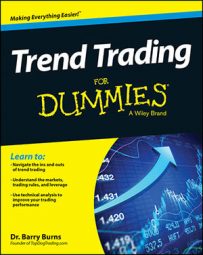The advance/decline line is a broad market indicator. This index provides indications of what the market you’re trading may do. Like the up/down volume index, the advance/decline line measures the difference between two indexes. Instead of volume, however, it measures the number of issues moving up and down. (An issue in this context is a symbol, such as a stock.)
Advancing issues versus declining issues
When charting advancing issues, you’re simply charting how many stocks are currently moving up. The advancing issues index can move in the same direction or a different direction than up volume because the group of stocks moving up includes different sizes (number of shares traded).
You can have more stocks moving up, but if they’re all small caps, then the up/down volume index can be moving down because although fewer stocks are moving down, they may trade more volume than the stocks moving up.
The declining issues index measures the number of stocks moving down at any given time, again regardless of the volume of those stocks.
The difference between the advancing and declining signals
In the same way you get signals from the up/down volume indexes by measuring the difference between them, you also get signals from the advancing and declining issues by measuring their difference.
Generally, the advance/decline line has more up and down swings than the up/down volume index. You can plot it as bars and apply a 20-period exponential moving average (EMA), which gives more weight to the most recent prices in calculating the average. (The period just refers to the number of bars on the chart used to calculate the average.)
Then use the angle of that average as your reference as to whether the advance/decline index is moving up or down.
Many data feeds have a single symbol for the advance/decline line. It may be something like ^ADD or $ADD. Ask your data provider for the symbol it uses.
The figure is an example of the advance/decline line (plotted with candlestick bars) with the 20-period EMA. Based on this chart, favor long trades until about 12:00 and then favor short trades after that when the 20 EMA of the advance/decline line turns down.
![[Credit: Figure by Barry Burns]](https://www.dummies.com/wp-content/uploads/448296.image0.jpg)
Wait for the up/down volume index and the advance/decline index to diverge. Then look to take a trade in the direction of the up/down volume index when the advance/decline index starts moving back in the direction of the up/down volume index. The up/down volume index is the dominant energy of the market the entire day, so trade in its direction.
The following figure illustrates one of these situations. Here, the pattern sets up between these two indexes, and the market creates a trend against the direction of the up/down volume index, allowing for a high-probability trend reversal trade (which is the highest reward-to-risk setup but generally has a low win/loss ratio).
![[Credit: Figure by Barry Burns]](https://www.dummies.com/wp-content/uploads/448297.image1.jpg)

